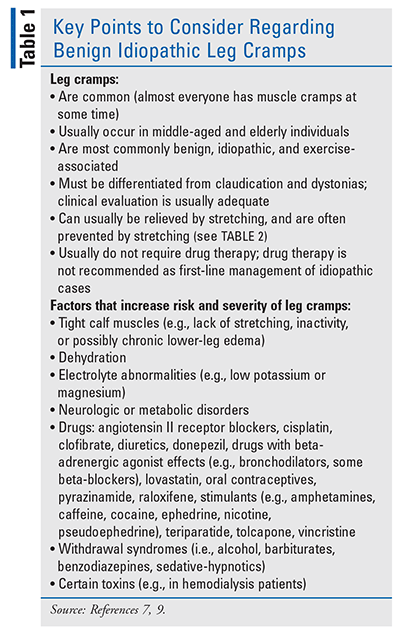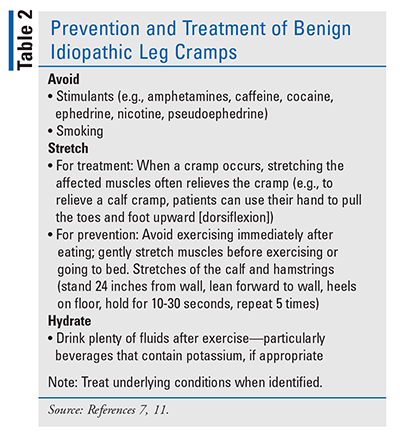US Pharm. 2020;45(6):5-8.
Waking up abruptly from sleep due to an acutely painful leg cramp can be a jolting experience. It may also be particularly troublesome when there is no awareness as to how to effectively intervene to mitigate this lower-limb muscle spasm and prevent it from reoccurring. The recurrent painful muscle tightening usually occurs in the calf muscles and not only can disturb sleep but can cause secondary insomnia.1 Nocturnal leg cramps, slightly more common in women, are reported by 50% to 60% of adults; prevalence increases with age.1 Approximately 20% of patients who experience leg cramps have symptoms on a daily basis, to the extent that it prompts them to seek medical attention.2-4
Certain medications (e.g., diuretics, angiotensin II receptor blockers, stimulants, cisplatin; TABLE 1) have been reported to cause leg cramps in some individuals, and muscle cramps are reported in as many as 35% to 86% of patients receiving hemodialysis.5,6 The most common types of leg cramps, however, are:
• Benign idiopathic leg cramps in the absence of a causative disorder, typically at night, and
• Exercise-associated leg cramps during or immediately after exercise7
Common risk factors for muscle spasms specific to older adults include strenuous exercise (idiopathic), hemodialysis, and cirrhosis.8 Idiopathic leg cramps are common, short-lived, and usually involve the calf muscle and/or the foot and thigh.9 The focus of this column is benign idiopathic leg cramps, although they can be associated with other underlying conditions.8

Pharmacists can provide guidance and recommendations as to how to proceed to find comfort, mitigation, and further evaluation, if appropriate, based on a patient’s medical history, medication therapy, and lifestyle issues. The pharmacist can also guide prescribers and patients to avoid 1) the addition of unnecessary medications; 2) the use of medication without supportive evidence in the treatment of nocturnal leg cramps; and 3) the risk of polypharmacy-associated adverse events, which are particularly troublesome in older adults.
Clinical Features
Nocturnal leg cramps are common occurrences among older, generally healthy adults (TABLE 1). Although mostly benign and self-limited, muscle cramps may also be indicative of a wide variety of potentially serious systemic disorders (e.g., endocrinologic, neurologic, and vascular disorders), treatment with certain drugs (TABLE 1), and occupational factors; a significant portion of cases are idiopathic.8,9
A muscle cramp is a sudden, involuntary, muscle contraction or spasm; leg cramps are painful and incapacitating, lasting an average of 9 minutes per episode.1,8 After the cramping has passed, patients may experience residual pain and tenderness in the affected leg for several hours.10 While the exact mechanism is unknown, the probable cause is thought to be muscle fatigue and nerve dysfunction rather than electrolyte or other abnormalities.1 With regard to idiopathic leg cramps, about 80% of episodes involve the gastrocnemius muscle in the calf, with a mean duration per episode of 8 to 9 minutes in adults.8 The posterior calf muscles (gastrocnemius and soleus) are usually involved, but cramps of the foot and thigh also are common.10 Leg cramps may be isometric or may cause limb movement, such as extreme plantar flexion of the foot.1 Description of leg cramps may include spasm, tightening, twinge, strain, tetany, swelling, or muscle seizure.1
Treatment and Prevention
The diagnostic approach for idiopathic muscle cramps is one of exclusion. Cramps due to known pathologies can be ruled out quickly and easily, within reason, by medical history and targeted physical exam.8 Testing is done as indicated by abnormal clinical findings; no tests are routinely done.7
Nonpharmacologic therapy forms the cornerstone of management of muscle cramps in the acute phase. Passive and/or active stretching of the affected muscle(s) is by far the most effective and safest therapy for most acute idiopathic muscle cramps.8 For those nonidiopathic cases, management involves treating the underlying cause, when possible.9
Data are extremely sparse regarding ongoing prevention of muscle cramps. With the exception of drug therapies targeted at underlying/precipitating conditions, there are no proven, specific, effective, and safe drug therapies for muscle cramps. Therapeutic trialing of various medications used for symptomatic benefit is a reasonable approach.8
Pharmacists should be aware that most drugs prescribed to prevent cramps (e.g., magnesium, calcium supplements, quinine, benzodiazepines) are not recommended due to lack of demonstrated efficacy.7 While quinine has been effective in some trials, it is no longer recommended in light of occasional serious side effects (e.g, arrhythmias, thrombocytopenia, thrombotic thrombocytopenic purpura and hemolytic-uremic syndrome, severe allergic reactions).7 Mexiletine may be helpful; however, whether beneficial effects outweigh the potential adverse effects (e.g., nausea, vomiting, heartburn, dizziness, tremor) is unclear.7 Small studies have supported the use of vitamin B complex, verapamil, and diltiazem; gabapentin has been used, but with little evidence to support its effectiveness.11 There is also an opportunity for pharmacists to guide patients regarding smoking-cessation modalities to eliminate nicotine as a causative factor in benign leg cramps and help to improve overall health outcomes (i.e., prevention of stroke, chronic obstructive pulmonary disease, heart disease).12-14
Stretching Exercises to Help Prevent Leg Cramps
Specific exercises (TABLE 2) improve muscle and tendon flexibility and can reduce muscle, nerve, or central nervous system neuronal activity in the stretched muscles. As an effective preventive measure, stretching is recommended for several minutes before sleep; as a treatment strategy, stretching immediately following the occurrence of a cramp commonly provides relief. TABLE 2 provides descriptions for each of these measures.

Pharmacists should underscore the importance of avoiding dehydration; patients should be educated about drinking plenty of fluids after exercise—particularly beverages that contain potassium, if appropriate.7 Medication is usually only needed in the most persistent cases in which cramping does not respond to exercise.10
Conclusion
Benign idiopathic leg cramps among older, generally healthy adults are a common nocturnal symptom. While short-lived—involving calf, foot, and/or thigh muscles—they can cause painful and recurrent symptoms, which have the potential to lead to secondary insomnia. With pharmacists’ awareness of and recommendations for stretching exercises, and referral for evaluation where appropriate, older adults can find comfort and learn mitigation and prevention strategies for these benign but distressful conditions.
The content contained in this article is for informational purposes only. The content is not intended to be a substitute for professional advice. Reliance on any information provided in this article is solely at your own risk.
REFERENCES
1. Allen RE, Kirby KA. Nocturnal leg cramps. Am Fam Physician. 2012;86(4):350-355.
2. Abdulla AJ, Jones PW, Pearce VR. Leg cramps in the elderly: prevalence, drug and disease associations. Int J Clin Pract. 1999;53(7):494-496.
3. Oboler SK, Prochazka AV, Meyer TJ. Leg symptoms in outpatient veterans. West J Med. 1991;155(3):256-259.
4. Leung AK, Wong BE, Chan PY, Cho HY. Nocturnal leg cramps in children: incidence and clinical characteristics. J Natl Med Assoc. 1999;91(6):329-332.
5. Ulu MS, Ahsen A. Muscle cramps during hemodialysis: what can we do? New approaches for treatment and preventing. Eur J Gen Med. 2015;12(3):277-281.
6. Schonder KS. Chronic and end-stage renal disease. In: Chisholm-Burns MA, Schwinghammer TL, Malone PM, et al, eds. Pharmacotherapy: Principles & Practice, 5th ed. New York, NY: McGraw Hill Education; 2019:425.
7. Levin MC. Muscle cramps. MerckManuals.com. Last full review/revision January 2019. www.merckmanuals.com/professional/neurologic-disorders/symptoms-of-neurologic-disorders/muscle-cramps. Accessed May 11, 2020.
8. Rubin M. Muscle cramps. Last reviewed: April 2020; Last updated: July 2018. https://bestpractice.bmj.com/topics/en-us/569. Accessed May 11, 2020.
9. Kanaan N, Sawaya R. Nocturnal leg cramps. Clinically mysterious and painful—but manageable. Geriatrics. 2001;56(6):34,39-42.
10. NHS Inform. Leg cramps. www.nhsinform.scot/illnesses-and-conditions/muscle-bone-and-joints/conditions/leg-cramps. Accessed May 11, 2020.
11. Reuben DB, Herr KA, Pacala JT, et al. Geriatrics at Your Fingertips: 2016. 18th ed. New York: The American Geriatrics Society; 2016:320.
12. Anderson KV, Honaker SE. Atrial fibrillation MTM data set. In: Whalen K, Hardin HC, eds. Medication Therapy Management: A Comprehensive Approach. 2nd ed. New York, NY: McGraw Hill Education. 2018:225-242.
13. Melin K, Maniscalco-Feichtl M. Chronic obstructive pulmonary disease MTM data set. In: Whalen K, Hardin HC, eds. Medication Therapy Management: A Comprehensive Approach. 2nd ed. New York, NY: McGraw Hill Education. 2018:285-295.
14. Anderson SD, Pardo KM. Chronic stable angina MTM data set. In: Whalen K, Hardin HC, eds. Medication Therapy Management: A Comprehensive Approach. 2nd ed. New York, NY: McGraw Hill Education. 2018:297-309.
To comment on this article, contact rdavidson@uspharmacist.com.





